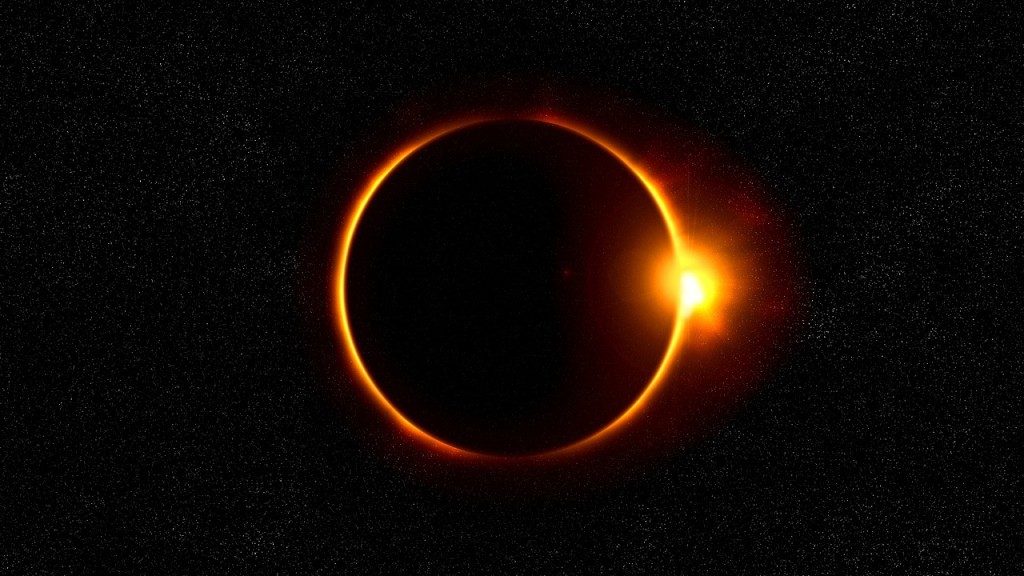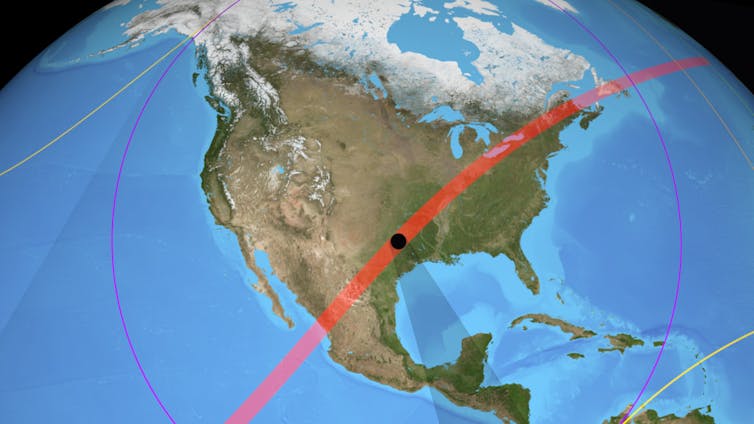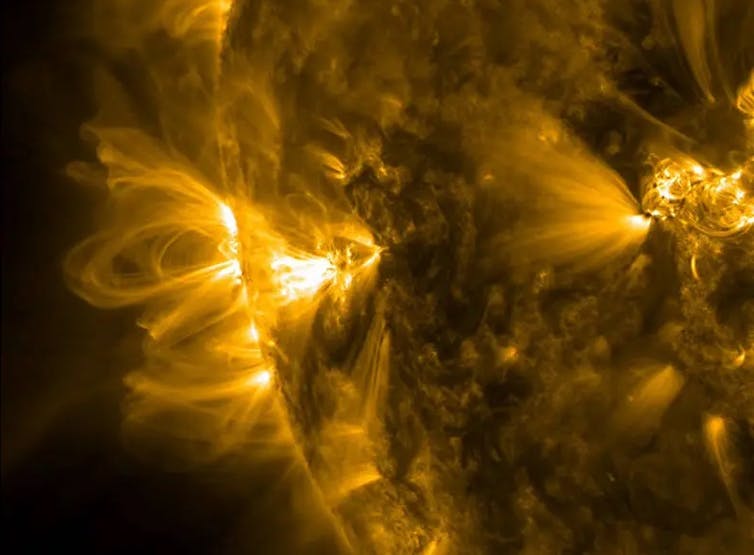
[ad_1]
 By The Dialog
By The Dialog
A whole photo voltaic eclipse takes place on April 8 throughout North America. These occasions happen when the Moon passes between the Solar and Earth, utterly blocking the Solar’s face. This plunges observers right into a darkness much like daybreak or nightfall.
In the course of the upcoming eclipse, the trail of totality, the place observers expertise the darkest a part of the Moon’s shadow (the umbra), crosses Mexico, arcing northeast by way of Texas, the Midwest, and briefly getting into Canada earlier than ending in Maine.
Complete photo voltaic eclipses happen roughly each 18 months at some location on Earth. The final whole photo voltaic eclipse that crossed the US occurred on August 21, 2017.
A global workforce of scientists, led by Aberystwyth College, shall be conducting experiments from close to Dallas at a location within the path of totality. The workforce consists of PhD college students and researchers from Aberystwyth College, NASA Goddard House Flight Middle in Maryland, and Caltech (California Institute of Know-how) in Pasadena.
There’s priceless science to be performed throughout eclipses which might be corresponding to or higher than what we will obtain through space-based missions. Our experiments might also make clear a longstanding puzzle in regards to the outermost a part of the Solar’s environment – its corona.
Pure Blaze is Google-Free — We Want Your Help
Contribute Simply $1 Per Month at Patreon to Support the Explanation for Well being Freedom

The Solar’s intense gentle is blocked by the Moon throughout a complete photo voltaic eclipse. Which means that we will observe the Solar’s faint corona with unbelievable readability from distances very near the Solar, out to a number of photo voltaic radii. One radius is the space equal to half the Solar’s diameter, about 696,000km (432,000 miles).
Measuring the corona is extraordinarily troublesome with out an eclipse. It requires a particular telescope referred to as a coronagraph that’s designed to dam out direct gentle from the Solar. This enables fainter gentle from the corona to be resolved. The readability of eclipse measurements surpasses even coronagraphs based mostly in area.
We will additionally observe the corona on a comparatively small funds, in comparison with, for instance, spacecraft missions. A persistent puzzle in regards to the corona is the commentary that it’s a lot hotter than the photosphere (the seen floor of the Solar). As we transfer away from a scorching object, the encompassing temperature ought to lower, not enhance. How the corona is heated to such excessive temperatures is one query we’ll examine.
Now we have two major scientific devices. The primary of those is Cip (coronal imaging polarimeter). Cip can be the Welsh phrase for “look”, or “fast look”. The instrument takes pictures of the Solar’s corona with a polarizer.
The sunshine we need to measure from the corona is extremely polarized, which suggests it’s made up of waves that vibrate in a single geometric airplane. A polarizer is a filter that lets gentle with a selected polarization go by way of it whereas blocking gentle with different polarizations.
The Cip pictures will permit us to measure basic properties of the corona, comparable to its density. It is going to additionally make clear phenomena such because the photo voltaic wind. It is a stream of sub-atomic particles within the type of plasma – superheated matter – flowing repeatedly outward from the Solar. Cip may assist us establish sources within the Solar’s environment for sure photo voltaic wind streams.
Direct measurements of the magnetic discipline within the Solar’s environment are troublesome. However the eclipse information ought to permit us to check its fine-scale construction and hint the sphere’s route. We’ll have the ability to see how far magnetic constructions referred to as massive “closed” magnetic loops prolong from the Solar. This, in flip, will give us details about large-scale magnetic situations within the corona.

The second instrument is Chils (coronal high-resolution line spectrometer). It collects high-resolution spectra, the place gentle is separated into its part colours. Right here, we’re searching for a selected spectral signature of iron emitted from the corona.
It contains three spectral strains, the place gentle is emitted or absorbed in a slim frequency vary. These are every generated at a unique vary of temperatures (within the hundreds of thousands of levels), so their relative brightness tells us in regards to the coronal temperature in several areas.
Mapping the corona’s temperature informs superior, computer-based fashions of its habits. These fashions should embody mechanisms for a way the coronal plasma is heated to such excessive temperatures. Such mechanisms may embody the conversion of magnetic waves to thermal plasma power, for instance. If we present that some areas are hotter than others, this may be replicated in fashions.
This yr’s eclipse additionally happens throughout a time of heightened photo voltaic exercise, so we may observe a coronal mass ejection (CME). These are enormous clouds of magnetized plasma which might be ejected from the Solar’s environment into area. They will have an effect on infrastructure close to Earth, inflicting issues for very important satellites.
Many facets of CMEs are poorly understood, together with their early evolution close to the Solar. Spectral data on CMEs will permit us to realize data on their thermodynamics, and their velocity and growth close to the Solar.
Our eclipse devices have not too long ago been proposed for an area mission referred to as Moon-enabled photo voltaic occultation mission (Mesom). The plan is to orbit the Moon to realize extra frequent and prolonged eclipse observations. It’s being deliberate as a UK House Company mission involving a number of international locations, however led by College School London, the College of Surrey, and Aberystwyth College.
We can even have a complicated industrial 360-degree digicam to gather video of the April 8 eclipse and the observing website. The video is efficacious for public outreach occasions, the place we spotlight the work we do and assist to generate public curiosity in our native star, the Solar.
This text is republished from The Dialog underneath a Artistic Commons license. Learn the authentic article.
The Dialog is a nonprofit information group devoted to unlocking the information of educational consultants for the general public. The Dialog’s workforce of 21 editors works with researchers to assist them clarify their work clearly and with out jargon.
Sourced from Examine Finds
Picture: Pixabay
[ad_2]